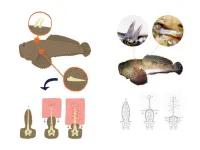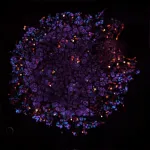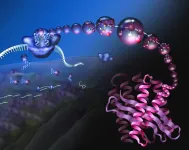(Press-News.org) The bright lights of big cities are wonders of the modern world; intended to help us work, stay safe and enjoy the world around us long after the sun has set. While artificial light has been great for increasing human productivity, some nocturnal animals, and even people, pay a price for this illumination. From increasing the amount of time that predators are active to disrupting migrations, light pollution affects many animals; but how do animals that use their own luminescence to lure food or attract mates fair against this new, brighter background? Female common glow-worms (Lampyris noctiluca) emit a green glow from their abdomen to attract flying males, but they are unable to fly themselves to new locations to escape light pollution. Because of this, Estelle Moubarak, Sofia Fernandes, Alan Stewart and Jeremy Niven of the University of Sussex, UK, wondered how hard it is for male common glow-worms to find mates in an ever-brighter environment. They publish their discovery that white light makes it harder for male glow-worms to find glowing females with potentially disastrous consequences for global glow-worm populations in Journal of Experimental Biology.
After collecting glow-worms at night from the South Downs, UK, Moubarak transported them back to the lab, before beginning the tricky task of transferring the male insects to a Y-shaped ‘maze’ without exposing them to artificial light. The team placed the male glow-worms at the bottom of the Y and a green LED, which mimicked a female’s glow, at the top of one of the arms, which the male had to walk toward. They then recorded if and how long it took the males to find the fake female. Then, the team switched on a white light above the maze, ranging from 25 Lux (25 times brighter than moonlight) to 145 Lux (equivalent to the light beneath a streetlamp). While all of the glow-worms found the LED in the dark, only 70% found the LED at the dimmest levels of white light, and just 21% of the insects found their potential mate in the brightest light.
Not only did the white light affect the glow-worm’s ability to find a female, but it also caused them to take longer to reach the LED. In the dark, the worms took ~48s to reach the female-mimicking LED, however, it took the same glow-worms ~60s to reach the LED in the lowest white light levels. Illuminating the maze also caused the male glow-worms to spend more time in the bottom part of the maze without moving towards a female. In the dark, the insects only spent ~32s in the bottom of the Y, while they spent ~81s in the bottom of the maze in the brightest conditions.
Moubarak suggests that male glow-worms were unable move towards the females when dazzled by white light because they cover their compound eyes with a head shield, which acts like a pair of sunglasses, reducing the amount of bright light they see. In fact, when the white light illuminated the area with the fake female LED, the glow-worms shaded their eyes for ~25% of the trial compared to only ~0.5% of the time when the maze was in the dark. ‘Keeping their eyes beneath their head shield shows male glow-worms trying to avoid exposure to the white light which suggests that they strongly dislike it,’ says Niven. So, while our bright night-time world has helped give rise to our modern society, it has had a drastic impact on male glow-worms and their ability to find mates. If this trend holds true, meadows and heaths across Europe and Asia that have lit up with the twinkling of the female glow-worms for millions of years will fall dark.
*****************************************
IF REPORTING THIS STORY, PLEASE MENTION JOURNAL OF EXPERIMENTAL BIOLOGY AS THE SOURCE AND, IF REPORTING ONLINE, PLEASE CARRY A LINK TO: : https://journals.biologists.com/jeb/article-lookup/doi/10.1242/jeb.245760
REFERENCE: Estelle M. Moubarak, E. M., Fernandes, A. S. D., Stewart, A. J. A. and Niven, J. E. (2023). Artificial light impairs local attraction to females in male glow-worms. J. Exp. Biol. 226, jeb245760. doi: 10.1242/jeb.245760
DOI:10.1242/jeb.245760
This article is posted on this site to give advance access to other authorised media who may wish to report on this story. Full attribution is required and if reporting online a link to https://journals.biologists.com/jeb is also required. The story posted here is COPYRIGHTED. Advance permission is required before any and every reproduction of each article in full from permissions@biologists.com.
THIS ARTICLE IS EMBARGOED UNTIL TUESDAY, 13 JUNE 2023, 18:00 HRS EDT (23:00 HRS BST)
END
URBANA, Ill. — Meat processing plants in the U.S. have garnered considerable public attention in recent years, often focusing on production and labor issues. The COVID-19 pandemic underscored the vulnerability of large, concentrated plants, as major shutdowns led to reduced output and higher meat prices for consumers.
Policy makers have launched initiatives at the state and federal levels to increase meat processing capacity and industry resilience, often favoring small and medium-sized plants. But little research exists to determine what factors make plants more likely to succeed. A new study from the University of ...
Philadelphia, June 13, 2023— Class I major histocompatibility complex (MHC-I) proteins play an essential role in the immune system of all jawed vertebrates. The MHC-I displays peptide fragments of proteins from within the cell on the cell surface, “presenting” them to the immune system, which is constantly scanning the body for foreign or toxic antigens. When foreign peptides are identified, they trigger a cascade that allows cytotoxic T cells to eliminate intruders. This process has been exploited in the development of both vaccines ...
A molecule found in the venomous toadfish Thalassophryne nattereri has proved capable of controlling lung inflammation and could be the basis for a more effective asthma drug. The research was supported by FAPESP and conducted by scientists at Butantan Institute in São Paulo, Brazil. An article describing the results is published in the journal Cells.
A welter of fish species live in freshwater, seawater and a mixture of the two, and some of them are venomous. They have spines or stingers connected to venom glands, which ...
Residents in rural counties with limited access to high-speed internet cannot take advantage of increasingly popular online health services.
A new study by the University of Cincinnati highlighted disparities in access to digital technology that could widen the gap in access to health care. The study found that socially vulnerable communities in the United States face more barriers to adequate health care, live in areas with fewer health care resources and have less access to high-speed internet.
The study was published in the journal Mayo Clinic Proceedings: Digital Health.
The Biden Administration announced this year it will invest $73 million in outreach ...
We have a good understanding of how a woman’s external features can change during pregnancy, but scientists know surprisingly little about what biological changes occur internally.
A new Northwestern Medicine study, published June 5 in the journal Frontiers in Immunology, provides data about immune cells and biological changes (gene expression) in pregnant people at multiple timepoints before and during pregnancy. Using RNA sequencing and computational methods to estimate proportions of different activated types of immune cells in blood the team of scientists showed how pregnancy induces progressive changes in the maternal ...
To help patients in need of transplants, artificial kidneys would have to function like their natural counterparts, but they wouldn’t necessarily have to look like them. With a new $1 million prize from the Kidney Innovation Accelerator, or KidneyX, a team of USC Stem Cell scientists led by Nils Lindström in collaboration with Leonardo Morsut are on a quest to build a kidney that resembles the real thing in function, but not in form.
“Nature has taught us that kidneys can come in an ...
Synthetic biologists have become increasingly creative in engineering yeast or bacteria to churn out useful chemicals — from fuels to fabrics and drugs — beyond the normal repertoire of microbes.
But a multi-university group of chemists has a more ambitious goal: to retool the cell's polypeptide manufacturing plants — the ribosomes that spin amino acids into protein — to generate polymer chains that are more elaborate than what can now be made in a cell or a test tube.
The $20 million research enterprise centered at the University of California, Berkeley, is ...
A new analysis provides a more complete picture of sickle cell disease mortality burden by combining disease prevalence data in different age groups and trends in overall survival when factoring in resulting secondary conditions.
When looking across all deaths, sickle cell disease is a leading cause of mortality in children under 5 years as well as in youth 5–14 years and adults 15–49 years.
Half a million babies were born with sickle cell disease in 2021, and 79% of these infants were in sub-Saharan Africa.
The largest increases ...
Billions of people around the world face water insecurity. Although there are numerous projects from governments, NGOs, and private corporations who are committed to providing safely managed water and sanitation by 2030, a new study advocates for more holistic evaluation of water, sanitation, and hygiene (WASH) interventions.
According to the study by Justin Stoler, associate professor in the University of Miami College of Arts and Sciences Department of Geography and Sustainable Development, issues ...
NEW YORK, June 13, 2023 – With the potential for artificial intelligence (AI) to create both massive disruption and great opportunity within the music industry, ASCAP — the only US PRO that operates on a not-for-profit basis — is introducing a slate of AI initiatives to help music creators navigate the future while protecting their work. These newly announced initiatives include: adoption by the ASCAP Board of Directors of a set of key ASCAP AI principles, creator education, startup incubation and policy development. Building upon ASCAP’s strong ...




